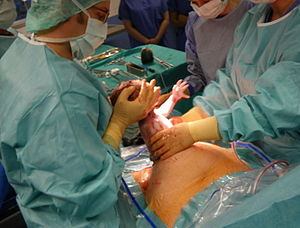
There are many incidents where women feel powerless in their medicalized childbirth experiences.
Insurance companies and doctors make choices for laboring women often without regard to what scientific studies have proven about risk factors involved with interventions.
Women who have given birth by Caesarean are almost always told they that is how they will have to give birth in subsequent deliveries. Many women seek out the rare hospital that will allow them to at least try a vaginal birth after Caesarean (VBAC) or a midwife who is not afraid.
Statistically, 40 percent of C-sections in the US occur in women with previous surgical births. Many doctors and insurance companies fear previous incisions will burst during labor; however, this occurs in only one percent of VBACs. When actual cases are documented and studied, the perceived risk is proven to be only slight.
The New York Times reported on an Australian study that found:
Women who choose to have a vaginal birth after a previous Caesarean section may be at a slightly increased risk of complications.
Researchers at the University of Adelaide in Australia studied 2,345 women who had had a Caesarean birth; 1,237 chose to have a subsequent vaginal delivery, while the rest chose a repeat Caesarean. All of the participants had full-term babies and were considered by their obstetricians eligible for a planned vaginal birth…
The researchers, led by Dr. Caroline A. Crowther, an obstetrician at the University of Adelaide, conclude that there is a slightly increased risk for fetal or infant death with a vaginal birth after Caesarean, but that the risk is not great. The authors added that their study provides no information about long-term risks.
These actual numbers show that a repeated c-section is not dramatically safer, yet insurance companies mandate them for fear of malpractice lawsuits. The National Institutes of Health (NIH) found:
We are concerned that medical-legal considerations add to, and in many instances exacerbate, these barriers to trial of labor. Policymakers, providers, and other stakeholders must collaborate in developing and implementating appropriate strategies to mitigate the chilling effect the medical-legal environment has on access to care.
The NIH found that even trying for a VBAC, even if it was unsuccessful, actually lowers the “risk of maternal mortality compared to elective repeat cesarean delivery,” especially in high volume hospitals.
For such a wealthy country with an advanced medical system, we have an astonishingly high rate of infant and maternal morbidity. Mothering.com calls it a “national disgrace”:
According to the Centers for Disease and Prevention ( CDC ) US infant and maternal mortality failed to improve between 2000 to 2005. This plateau represents the first time since the 1950s that infant mortality has seen no improvement. The US spends more than any other country in the world on health care and yet is only 33rd in the world in infant mortality. A baby born in Cuba, Slovenia, the Czech Republic or South Korea has a greater chance of living for the first year than a baby born in the US. In fact, a baby born in Singapore has twice the survival rate of a US baby.
We need to put the “medical-legal considerations” aside and honestly look at statistics. Birth needs to be humanized, no matter whether vaginal or Caesarean preceded it.
I think another factor they forget to look at is that that slight increase applies to your second delivery only. I am facing the issue of being a mom who wants 6+ kids, but knowing that I will probably not be able to find a doctor and hospital who will support me in VBACs and that my c-sections will become increasingly dangerous with each baby. It may even limit how many kids I can have. Anyway, I wish these studies/headlines would say something like “VBACs slightly riskier than c-section for second pregnancy” to make it clear that they aren’t studying what’s safest for the 3rd, 4th, etc pregnancies in these studies.
Good point! My aunt had 6 C-sections!